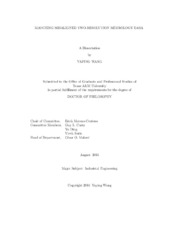| dc.description.abstract | Multi-resolution metrology devices co-exist in today's manufacturing environment, producing coordinate measurements complementing each other. Typically, the high-resolution device produces a scarce but accurate dataset, whereas the low-resolution one produces a dense but less accurate dataset. Research has shown that combining the two datasets of different resolutions makes better predictions of the geometric features of a manufactured part. A challenge, however, is how to effectively match each high-resolution data point to a low-resolution point that measures approximately the same physical location. A solution to this matching problem appears a prerequisite to a good final prediction.
This dissertation solves this metrology matching problem by formulating it as a quadratic integer programming, aiming at minimizing the maximum inter-point-distance difference (maxIPDdiff) among all potential correspondences. Due to the combinatorial nature of the optimization model, solving it to optimality is computationally prohibitive even for a small problem size. In order to solve real-life sized problems within a reasonable amount of time, a two-stage matching framework (TSMF) is proposed. The TSMF approach follows a coarse-to-fine search strategy and consists of down-sampling the full size problem, solving the down-sampled problem to optimality, extending the solution of the down-sampled problem to the full size problem, and refining the solution using iterative local search.
Many manufactured parts are designed with symmetric features; that is, many part surfaces are invariant (are mapped to themselves) to certain intrinsic reflections and/or rotations. Dealing with parts surfaces with symmetric features makes the metrology matching problem even more challenging. The new challenge is that, due to this symmetry, alignment performance metrics such as maxIPDdiff and root mean square error are not able to differentiate between (a) correct solutions/correspondences that are orientationally consistent with the underlying true correspondences and (b) incorrect but seemingly correct solutions that can be obtained by applying the surface's intrinsic reflections and/or rotations to a correct set of correspondences. To address this challenge, a filtering procedure is proposed to supplement the TSMF approach. Specifically, the filtering procedure works by generating a solution pool that contains a group of plausible candidate sets of correspondences and subsequently filtering this pool in order to select a correct set of correspondences from the pool.
Numerical experiments show that the TSMF approach outperforms two widely-used point set registration alternatives, the iterative closest point (ICP) and coherent point drift methods (CPD), in terms of several performance metrics. Moreover, compared to ICP and CPD, the TSMF approach scales very well as the instance size increases, and is robust with respect to the initial misalignment degree between the two datasets. The numerical results also show that, when enhanced with the proposed filtering procedure, TSMF exhibits much better alignment performance than TSMF without filtering, CPD and ICP in terms of both orientation correctness of the selected solution and several other performance metrics. Furthermore, in terms of computational performance, TSMF (with and without filtering) can solve real-life sized metrology data matching problems within a reasonable amount of time. Therefore, they are both well suitable to serve as an off-line tool in the manufacturing quality control process. | en |


